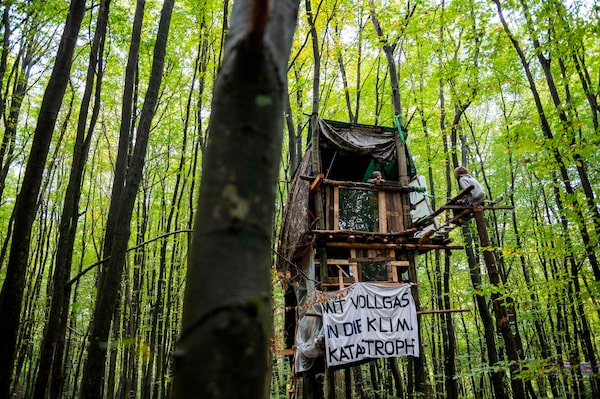Good afternoon, and welcome to Globe Climate, a newsletter about climate change, environment and resources in Canada.
Earlier this year, an aspiring paleontologist discovered a rare dinosaur skeleton at Horseshoe Canyon in the Badlands region of Alberta.
Nathan Hrushkin, a Grade 7 student from Calgary, is probably going to have a “pretty killer résumé" after the find. But his discovery might do more than that.
François Therrien, curator of dinosaur paleoecology at the Royal Tyrrell Museum, said the find can help archaeologists learn more about not just the evolution of dinosaurs, but also how they responded to their changing climate and environment.
Now, let’s catch you up on other news.

Aspiring paleontologist Nathan Hrushkin, a Grade 7 student from Calgary discovered a rare dinosaur skeleton earlier this year at Horseshoe Canyon in the Badlands region of southeastern Alberta.The Canadian Press
Noteworthy reporting this week:
- The use of natural gas in homes is coming under fire after years of being touted by Canada’s energy industry as an ideal fuel in the transition to a low-carbon economy. The Canadian Association of Physicians for the Environment is calling for B.C. homeowners to switch over to electricity-powered appliances.
- Could carbon tariffs be coming to Canada soon? The policy lever has flown under the radar in Canadian politics, but if Ottawa is serious about besting its Paris Agreement commitments, and carbon pricing is to play a major role then a carbon tax on imports could be in the offing. Adam Radwanski’s column this week explores the topic.
- A new all-Canadian electric vehicle has the potential to help transform the country’s automotive sector, even if it never actually makes it to the road. More than being geared toward consumers, the Arrow is an audacious attempt to give Canada a selling point as it tries to attract investment in EVs.
A deeper dive
Going nuclear
Ryan MacDonald is a senior editor at The Globe heading the climate, environment and resources team.
Governments are starting to place their bets on the energy transition.
The news that Ottawa is investing $20-million to aid Oakville, Ont.-based Terrestrial Energy Inc. to develop its small nuclear reactor technology is the latest in a wave of announcements coming from government around energy.
And when governments start to invest in companies directly, it’s a signal of where the cards are starting to be played in industrial policy.
Terrestrial is one of a host of companies in a race to commercialize a new generation of reactors and win a share of the low-carbon energy market. In the U.S., a Washington-based company chaired by Bill Gates called Terrapower is getting its own grants from government with an aim to build its first domestic facility. Canada, for its part, believes it has a competitive advantage largely due to its nuclear successes so far. And the provinces are lining up to take part.
Small-scale nuclear technology has been talked about for years, but with the cost of renewable-energy based systems dropping quickly, is a 300-megawatt reactor anything more than a distraction? Does using nuclear technology in the oil patch to lower emissions while extracting crude from the earth really represent progress?
To reach Canada’s goal of net-zero greenhouse gas emissions by 2050, watch for a mix of low-carbon energy investments from all levels of government. Nuclear is one, hydrogen is another, geothermal is another.
What all these investments have in common is one thing: jobs. The federal government estimates that by 2040 there will be 6,000 jobs in the small nuclear reactor sector in Canada, which will make a $2-billion contribution to the economy. Ottawa’s highly anticipated hydrogen strategy – to be released this fall – is touting the same kind of economic returns.
We are in interesting times. Governments are at once trying to balance the transition to a low-carbon economy with a green recovery during a global pandemic. There will be many, many more $20-million cheques.
And that may be the biggest bet of all.
- Ryan
What else you missed
Silver particles in consumer goods found to harm fish in Ontario lake study: Researchers who laced a Northern Ontario lake with the material as part of a multiyear experiment say the adverse effects they measured in two species of fish were significant enough to warrant including the unregulated substance as part of Canada’s water safety guidelines for the metal.
New quantum centre in Ontario to probe nature’s deepest and weirdest secrets: Quantum matter is the basic science behind everything, from the next generation of supercomputers to power lines that can transmit electricity without losing any of it.
Great Barrier Reef might lose its ability to recover from bleaching: Record-breaking temperatures that triggered bleaching events in 2016 and 2017 have meant fewer small, baby corals and breeding adult ones.
Quebec oceanographer Louis Fortier became a leader in Arctic research: He wasn’t one to let an opportunity slip through his fingers – especially not at the 11th hour. Dr. Fortier died on Oct. 4 from complications related to leukemia. He was 66.
Opinion and analysis
Future of Keystone XL hinges on U.S. presidential race
Kelly Cryderman: “It’s easier for an American politician to condemn a pipeline project originating in Canada, long in the crosshairs of environmental groups, than to run on policies that will cost existing jobs in Ohio or New Mexico. But it’s a quandary for Alberta. Four out of five barrels of Canadian oil are shipped south of the border.”
The world is betting on clean hydrogen – and Canada needs to get in the game
Merran Smith and Sarah Petrevan: “Hydrogen offers Canada an opportunity to sustain its role as an energy leader while cementing a role as a climate one.”
Here’s what readers had to say
‘Plastic bags should be the last plastics to go.’ Readers react to Canada’s plastics ban, plus other letters to the editor
Re Ottawa’s Pledge To Ban Some Single-use Plastics Will Hurt Alberta’s Recovery, Kenney Says (Oct. 10): Plastics, especially single-use items, are having a negative effect on the climate. We should have national standards on the composition of plastics so they can be recycled or reused, while some are eliminated entirely.
Ottawa’s announcement should be seen as a good thing for Alberta: Now the province can plan to expand the petrochemical sector in a meaningful way and perhaps become a world leader in that regard.
Stephen Crocker Edmonton
Read other letters to the editor about plastic here
Making waves
Each week The Globe will profile a young person making a difference in Canada. This week we’re highlighting the work of Julia Sampson, who organizes in the climate justice movement.

Julia SampsonHandout
My name is Julia Sampson (she/they) and I’m an 18-year-old student climate activist in Kjipuktuk (Halifax). I was involved in climate justice work when the first climate strike in Kjipuktuk was organized. We also planned a climate strike that took place September 25. I’ve been working with Climate Strike Canada, the national strike group in so-called Canada since 2019.
I organize in the movement because the climate crisis is not only threatening my future but also my present. Just last year we were hit by Hurricane Dorian and parts of Nova Scotia had no power for weeks. But this is about more than just how the climate crisis affects me; it’s about how it affects marginalized communities in the form of environmental racism.
Last year we celebrated the success of a coal mine project being cancelled in Pictou County due to local activism. This year, on a national level, we celebrated the Teck mine being rejected. This shows that grassroots organizing works. Whether it’s in the form of organizing direct actions, attending them, promoting them or donating and signing petitions, anything helps.
Do you know an engaged young person? Someone who represents the real engines pursuing change in the country? Email us at GlobeClimate@globeandmail.com to tell us about them.
Photo of the week

Activists sit at a tree house in a protest camp against the construction of the motorway A49 inside the Dannenroeder forest on October 15, 2020. Activists live in camps inside the Dannenroeder forest to protest against the deforestation for the planned A49 motorway leading through the forest.THOMAS LOHNES/AFP/Getty Images
Guides and Explainers
- We’ve rounded up our reporters’ content to help you learn about sustainable ways to live life at home, travel, invest, and generally to learn about our species at risk.
- If you like to read, here are books to help the environmentalist in you grow, as well as a downloadable e-book of Micro skills - Little Steps to Big Change.
Catch up on Globe Climate
- It’s a plastic world after all
- Special edition part 2: Down to business
- Special edition part 1: Fire and ice
- Is it time for Big Oil to kill itself slowly?
We want to hear from you. Email us: GlobeClimate@globeandmail.com. Do you know someone who needs this newsletter? Send them to our Newsletters page.
 Sierra Bein
Sierra Bein